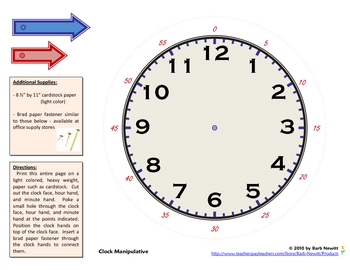
This is a more difficult concept- save it for later, but keep it in the back of your mind for when YOUR child is ready. If Bob goes to the zoo at 9:00 and gets home at 11:00, how many hours was Bob at the zoo. Passage of Time: As children develop you can start talking about the passage of time.
Teaching time clock face how to#
When this concept is solid, you can show him how to count around the clock by 5s and then add on the number of minutes. Once your child understands this concept, you can begin to teach times such as 8:05 or 8:35 by showing him how to count by 5s around the clock. Explain to your child that there are 5 minutes between each number on the clock. You should add 4 lines between each number on your teaching clock at this point to help teach this concept. Telling Time to the Minute: This is where counting by 5s is and a more detailed clock is essential. This time divide the clock in quarters and color each quarter a different color to help with the concept. Again this concept is harder than o’clock and half past and is typically introduced in grade one and mastered by grade two or three (depending on the child). Quarter to/Quarter Past: Follow the same routine as above, but add in quarter to/quarter past, :15 and :45. Take a crayon and shade in half the clock one color and the other half another color to SHOW half. Half-Past/ :30: Usually half past/ :30 is the next clock skill addressed after “o’clock.” Follow a similar routine as above. That said, it is never to early to start and there are lots of great songs out there about counting by 5s. This is typically a skill taught in Grade 1. Do not expect young children to be able to count by 5s. Practice counting by fives with and without the clock. Do this several times and then have your child give it a try.Ĭounting by 5s: Counting by 5s is an important skill for telling time.

Put the minute hand on 12 and the hour hand on 1 and say, “It is one o’clock because the hour hand is on the one and the minute hand is on the twelve.” Then move the hour hand to another number and repeat. Tell your child that when the big hand or the minute hand is on the 12, it is always an “o’clock” time. O’Clock: O’Clock is usually the first time concept introduced and kids actually catch on quite quickly. Highlight the fact that the hour hand is shorter than the minute hand and the hour hand moves more slowly than the minute hand. Hour Hand and Minute Hand: Take what you did above a step further and talk with your child about how the two hands work together and how they move around the clock. Then take all the parts of the clock off and put it back together- together! Show where the numbers start and how you “go around the clock.” Show how the hands and the numbers work together. Explain about the two hands on the clock and how they are different and how they are the same. Pull out this teaching clock (all parts in place) and tell your child about it. That is why it is important to stop, rewind and start from the beginning. Maybe not, but why not give them the knowledge and see what they do with it!Ĭlock Face: I think we often assume that children know certain things and they don’t. Do they need to know or even use these words? Maybe. Explain to your child that this is an analog clock and then show them a digital clock and talk about their differences and similarities.


cardboard circle (I cut mine from a box).I wanted something that could be taken apart and put back together and I wanted something that could be adapted to his learning needs as he develops. So I created a teaching clock to use with him. I can tell by some of the things he has said that they have touched on it at school, but that is about all. My son has recently become interested in telling time.


 0 kommentar(er)
0 kommentar(er)
